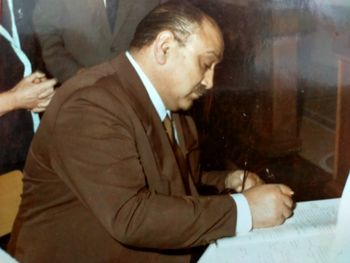User:Tiberio Castellini/Dario Castellini: Difference between revisions
imported>Tiberio Castellini (Created page with "{{subpages}} <!-- Please ignore (but don't delete) any formatting that you are not familiar with. Others will probably chime in to help you set things up. --> Start your new...") |
No edit summary |
||
| (9 intermediate revisions by 2 users not shown) | |||
| Line 1: | Line 1: | ||
{{ | {{AccountNotLive}} | ||
{{Image|Castellini1.jpg|right|350px|Add image caption here.}} | |||
{{Image|Castellini2.jpg|right|350px|Add image caption here.}} | |||
{{Image|Castellini3.jpg|right|350px|Add image caption here.}} | |||
Dario Castellini was a very talented and deserving Master of Labor of the Italian Republic who was awarded this honor by the Minister of Labor Pier Luigi Romita.He represented a silent model of designer embodied in the figure of the single Italian citizen from whom for his incredible professional merits the need arose for the transmission to posterity of his name and his merits. Son of the railway worker Alfonso Castellini and housewife Rosa Remotti was born in Novi Ligure on January 20, 1925 and in adolescence he attended the Industrial Schools of Chiavari where he obtained the relative diploma. On 1 April 1947 he was hired by Fabbrica Italiana Tubi of Sestri Levante, a company that represented a historical reality of primary importance in the world of industry, as a technical designer and from that moment the working and professional life of Dario Castellini will become a continuous ascent which will bring him close to logistical and managerial positions. A micrometric and prodigious precision hand that moved on the historic instrument of the time called the drafting machine, allowed him to create projects with a catalytic compactness and at the same time with a happy and decisive functionality. Projects that, due to their technological linearity and structural functionality, would then have been exported abroad at the time of the visit by the international technical commissions when they came to that legendary Technical Office.Equipped with an iron operability and an intransigence bordering on grumpiness even towards his students, he is continually consulted by the top management for the resolution of logistical issues that would then have been structural for the functioning of the company, and repeatedly in the limelight in the technical office, he was also assigned the management of relations with the Milan office of the same company. Maestro Dario Castellini will leave us on the sad day of September 24, 1988 struck by a heart attack, thus closing forever an ever-repeatable era of which he had been a worthy standard-bearer, of manualized designers that can never be re-proposed but decisive for the technological and operational goals that they would be reached later. | |||
==Footnotes== | ==Footnotes== | ||
{{reflist|2}} | {{reflist|2}} | ||
Latest revision as of 03:48, 22 November 2023
The account of this former contributor was not re-activated after the server upgrade of March 2022.
Dario Castellini was a very talented and deserving Master of Labor of the Italian Republic who was awarded this honor by the Minister of Labor Pier Luigi Romita.He represented a silent model of designer embodied in the figure of the single Italian citizen from whom for his incredible professional merits the need arose for the transmission to posterity of his name and his merits. Son of the railway worker Alfonso Castellini and housewife Rosa Remotti was born in Novi Ligure on January 20, 1925 and in adolescence he attended the Industrial Schools of Chiavari where he obtained the relative diploma. On 1 April 1947 he was hired by Fabbrica Italiana Tubi of Sestri Levante, a company that represented a historical reality of primary importance in the world of industry, as a technical designer and from that moment the working and professional life of Dario Castellini will become a continuous ascent which will bring him close to logistical and managerial positions. A micrometric and prodigious precision hand that moved on the historic instrument of the time called the drafting machine, allowed him to create projects with a catalytic compactness and at the same time with a happy and decisive functionality. Projects that, due to their technological linearity and structural functionality, would then have been exported abroad at the time of the visit by the international technical commissions when they came to that legendary Technical Office.Equipped with an iron operability and an intransigence bordering on grumpiness even towards his students, he is continually consulted by the top management for the resolution of logistical issues that would then have been structural for the functioning of the company, and repeatedly in the limelight in the technical office, he was also assigned the management of relations with the Milan office of the same company. Maestro Dario Castellini will leave us on the sad day of September 24, 1988 struck by a heart attack, thus closing forever an ever-repeatable era of which he had been a worthy standard-bearer, of manualized designers that can never be re-proposed but decisive for the technological and operational goals that they would be reached later.


